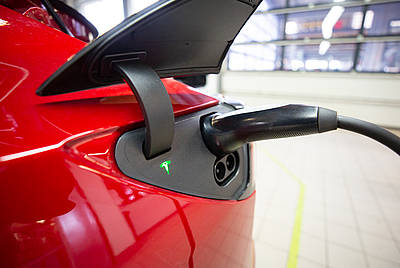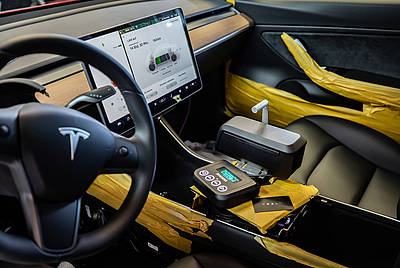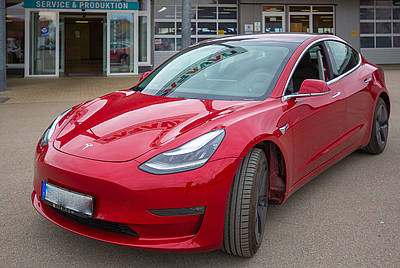- Discussions about alternative drive systems following diesel bans in large cities
- High procurement costs and low operating ranges
- Barrier-free access to electric vehicles is difficult to achieve.
PFRONSTETTEN-AICHELAU. The debate surrounding bans on diesel vehicles in city centres in Germany has led to a lot of uncertainty among Paravan customers. “More than 95 per cent of our customers purchase diesel vehicles because of their long service life and low fuel consumption”, says Marketing Director Alexander Nerz. While it’s true that drivers with certain types of disability cards are exempt by law from the diesel bans in large cities, many customers are nevertheless putting off the purchase of a new vehicle. “We will present an electric vehicle conversion of a BMW i3 at REHAB – with an accelerator ring and entry assistance”, says Nerz. “In addition, we will be highlighting the opportunities electric mobility offers, but we will also point out the limits to what’s feasible at the moment.”
Electric vehicles are currently rarely to be seen in the production halls at the PARAVAN mobility park in Aichelau. “We’ve converted a few Tesla vehicles, including the Cloui prototype, and we’ve also conducted various industrial projects”, Nerz explains. Still, the number of requests for such conversions is increasing. At the moment, for example, a Tesla Model 3 is being equipped with Space Drive, an acceleration/brake lever on the right side, and a rear Ladeboy lift Customers can definitely benefit from the additional technology and electronic systems available in Tesla vehicles. In the latest Tesla project, the participating customer was able to use the standard electronic steering unit that can be operated with a force application of around 8 Nm. Conventional power steering systems require a force of 14 Nm or more to operate. There’s also the fact that these values can increase at higher speeds – and such a level of exertion is often not possible for many drivers with neurological or muscle diseases. Drivers can also operate virtually all assistance systems installed in the Tesla. Particularly useful is the system for automated driving on motorways from the joining slip road to the exit, including changing motorways at interchanges and overtaking slower-moving vehicles.
Several electric models from the compact segment are already available on the market. These include the BMW i3, the Hyundai Kona, the Audi Etron and the e-Golf, as well as models from Tesla, Kia, Renault, Nissan and Jaguar and, coming soon, the Mercedes EQC as well. Still, these models are only suitable for drivers who have sufficient strength to transfer to the driver seat and are able to operate a wheelchair-loading system. Things are also moving forward in the small van and bus segment with the eSprinter and eVito from Mercedes Benz and, scheduled for launch next year, an electric version of the VW Bulli van. Similar models are also being planned by other car manufacturers.
One problem remains, however: Mobility solutions for people with physical limitations need to be barrier-free – and the possibilities for ensuring barrier-free access for wheelchair users who need to move right up to the steering wheel are very limited due to the design of electric vehicles, and in particular the position of the battery.
“The installation of a lift, or a loading ramp for that matter, is going to be difficult”, says Mario Kütt, Head of Technical Development at PARAVAN GmbH. “The batteries are almost always installed in the floor assembly, which is exactly what our conversions focus on when we make changes to the body or the underbody.” What’s more, the additional devices consume a lot of electricity, which negatively impacts vehicle range. “Additional batteries will also more than likely need to be installed for the transfer seat base or cassette lift”, Kütt points out. It’s also not clear whether the conventional cassette lift can even be installed in the underbody of an electric vehicle. “We’ll probably have to come up with a flatter solution here”, Kütt explains. Overall vehicle weight could also pose a problem in future. “The installation of a lift on the inside will probably still be possible”, says Kütt. Nevertheless, this variant is not very popular among customers; something the team from Technical Customer Consulting is well aware of.
On the other hand, the installation of electronic driving aids such as joysticks or acceleration/brake levers won’t be a problem at all. “Space Drive is a retrofit solution”, says Rolf Gramenske from the Technical Sales department at Schaeffler Paravan Technologie GmbH & Co. KG. “The redundant servo motors do the same things that people normally do. Ultimately, acceleration, braking and steering are all carried out in an analogue manner.”
However, battery recharging during a trip could be a problem. Wheelchair users need to have enough room available to open the driver’s door or to leave the vehicle via a ramp – but parking spaces with recharging stations generally have a standard width.
Another problem with electric vehicles is that they cost a lot, which is why customers are very hesitant to buy one, regardless of whether or not it’s been adapted. “I believe that higher subsidies that might be made available for purchasing a base model could create new opportunities here”, says Manuel Strohm, a technical consultant who is also responsible for obtaining licences at PARAVAN. In any case, small agile electric cars could offer a real alternative to drivers who are able to transfer in and out of wheelchairs and do all of their driving within a city.





